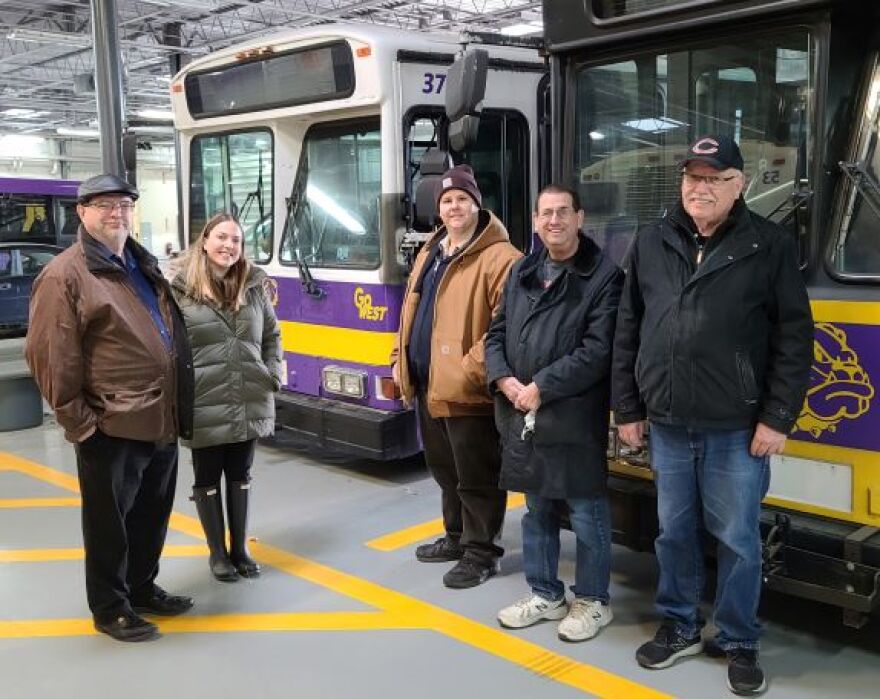Tom Schwartz has loved buses since he was a kid.
“I guess you could say I was the bus nerd. Even when I was little kid, I would get thrilled when I saw the bus coming,” he said.
Schwartz said he could tell if an approaching school bus was a newer or older vehicle by the condition of its yellow paint. He would keep track of manufacturers and what year the buses were made.
In addition, he had a collection of Matchbox, Hot Wheels, and other toy buses.
Now, Schwartz is the Director of Operations for the Johnsburg School District in northern Illinois. As part of his job, he oversees transportation for the district.
He also is President of the Midwest Bus Museum in Richmond, Illinois. He came to Macomb in mid-November to acquire two public transit buses that McDonough County Public Transportation (MCPT) recently retired and donated to the museum.
“We are just thrilled to be getting them and be able to preserve them in our collection,” Schwartz said.
The vehicles are Gillig Phantom buses produced by Gillig Corporation in the 1990s and early 2000s. Schwartz said the Phantom buses are the last models of what were called high floor buses – passengers had to make their way up two or three steps to get on the bus. The buses had wheelchair lifts but they were slow and cumbersome.
Buses built today have a low floor up front for boarding and ADA seating, then stairs further back where there is more seating.
“Having the low-floor buses and less moving parts, and just having a wider, larger area for that accommodation, and having the availability for more ADA seating area has made the low-floor the king of the transportation industry today,” Schwartz said.

The Midwest Bus Museum
The museum was incorporated in 2020. Schwartz said he and another bus collector came up with the idea as a way of displaying their collections to the public.
The museum is placing an emphasis on school buses. Schwartz said that is their core passion.
“There are other transportation museums, but no one really focuses on or emphasizes school buses,” he said.
“We want to have representations of the different body manufacturers over the different eras, and collect a piece of the transportation industry that kind of got forgotten.”
However, he said the collection currently is about a 50/50 split of school buses and public transit models.
For now, the buses are stored on private property. Museum members are fundraising for a permanent site for a public, indoor facility. In the meantime, the collection is available for viewing for special events.
Schwartz said they would like to stay in McHenry County for the permanent museum site. He said the county is already home to the Illinois Railway Museum, which he called the largest railway museum in North America. He said they might draw some of the same visitors by having the two museums near each other.
The oldest vehicle in the bus museum’s collection is a 1942 Twin Coach.
“All the buses have an interesting story on how they survived all these years. This particular 1942 Twin Coach survived because it was modified and made into a sightseeing bus,” Schwartz said.
“They literally chopped the top off, changed the seats out, and it was known as the Tenne-seer – it was used for sightseeing in Tennessee.”
He said it ended up in an Indiana junkyard before the museum found it and saved it. They’ve cleaned it up and use it for tours and sightseeing.
How MCPT got involved
Miranda Lambert, Director of MCPT, said when her agency retires a bus, it checks with the Illinois Department of Transportation (IDOT) to see if the vehicle can be used by any other agency in the state. If not, they usually end up getting sold, often for scrap.
But in the case of the two newly retired buses, she said Jeff Waxman of IDOT suggested something else – donating them to the museum.
“When he saw that we were disposing these two items, and saw the type of buses they were, he touched based with the museum to see if they currently had those type of vehicles,” Lambert said.
“And once they realized there was a void there, he reached out to see if the city would be interested in donating them to the museum.”
Lambert said MCPT replaced the two donated buses with 2019 New Flyer low-floor buses for its fleet.
Tri States Public Radio produced this story. TSPR relies on financial support from our readers and listeners in order to provide coverage of the issues that matter to west central Illinois, southeast Iowa, and northeast Missouri. As someone who values the content created by TSPR's news department please consider making a financial contribution.



